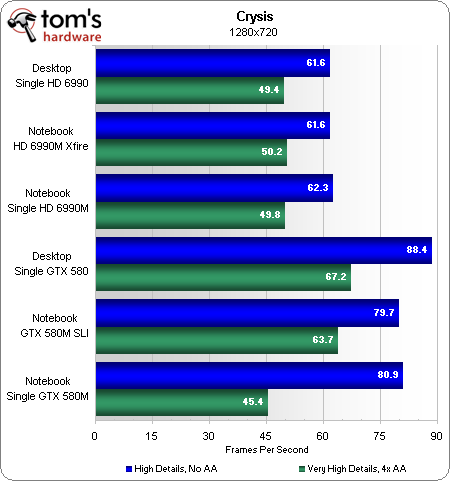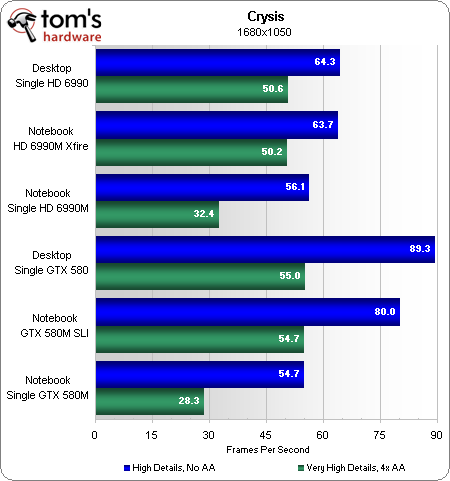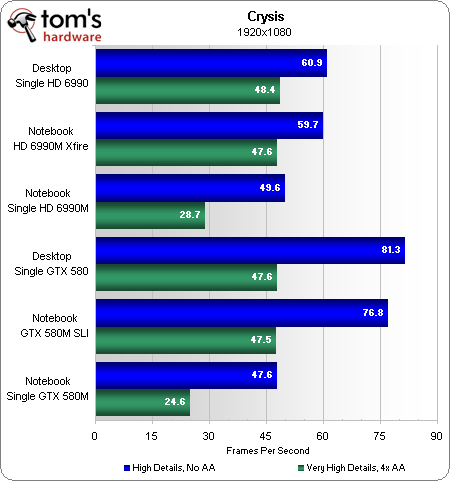Radeon HD 6990M And GeForce GTX 580M: A Beautiful Lie
We’ve been more than outspoken about the naming AMD and Nvidia use for their mobile GPUs. Are they really trying to mislead buyers, though? We briefly examine their methodology and frame that against the limitations of high-end mobile computing.
Benchmark Results: Crysis
Retired immediately after our previous GeForce GTX 580M review, Crysis has shown us bottlenecks in everything from GPUs to storage subsystems. GPU performance scales a little faster than CPU performance, which is one of the reasons we began looking for newer benchmarks to stress our graphics configurations.
This could be the perfect example of why so many owners of AMD cards insist they be tested on overclocked Intel platforms: the Radeons appear more CPU-bottlenecked than the GeForce solutions, and even the stock Core i7-990X CPU used by all configurations isn’t enough to overcome that shortcoming.
Big spenders don’t want to play their games at 1680x1050. But, if they had to, they’d find both of the single-GPU mobile configurations to be unacceptably slow using High quality details and 4x AA. The dual-GPU setups remain CPU-bottlenecked, for the most part.
Our highest 1920x1080 settings are where AMD's Radeon HD 6990M CrossFire finally catches up to the GeForce GTX 580M in SLI. The desktop card needs even higher resolutions to prove its superiority, but this is the point where we run out of scalability on the notebook's panel.
Both AMD and Nvidia demonstrate a single desktop card outpacing two of their notebook-oriented modules named too similarly for our comfort, which starts to illustrate our point about customers potentially being led astray as they spec-out their notebooks. A higher available resolution would have simply driven this point home more definitively.
Get Tom's Hardware's best news and in-depth reviews, straight to your inbox.
Current page: Benchmark Results: Crysis
Prev Page Test Settings And Benchmarks Next Page Benchmark Results: Just Cause 2-
Yargnit The HD 6990M is certainly the worst in a long line of ever-increasing false advertising by GPU manufacturers when it comes to their mobile cards.Reply
Every generation is more guilty than the one before, but AMD indeed hit a new low when they used the name of their dual-GPU flagship to go along with a single-GPU mobile card. (Not even based off the same GPU at that)
I wonder what the chances of someone successfully filing a false advertising suit for this would be? Especially in the EU where they seem much stricter about that stuff than the US is, I'd have to think they'd have a decent shot. (This is at least as bad as the whole LED/LCD TV thing that the courts ruled against the manufacturers on)
I can let some reasonable under-clocking (say 25% at most) get by for mobile GPU's under the same name, but they should have to be based off the same GPU as the desktop card that they are named after at least, and in the case of using the name of a dual-GPU card they should actually have to be dual GPU cards.
Either put an actual 6990 in the laptop, or call it a HD 6870m. -
Inferno1217 This is nothing new to the laptop world and is common knowledge. You can't expect 580 or 6990 desktop performance out of a mobile 580 or 6990 solutions (note the M at the end). This article may help newcomers understand the differences between mobile and desktop gpu's.Reply -
Crashman el33tWhat on earth took you guys so long to realize this??This is something like the third article to point these problems out, but it's the first to use the desktop 6990. Tom's Hardware simply doesn't have enough 6990's for every tester to have his own :)Reply -
alanim Normally I wouldn't really see a problem with this, because as far as I understand the numbers are just there to show a tier on how powerful the graphics cards are, and since this is the 6990M, one would assume that it's the highest tier for the current generation mobile graphics card.Reply
Now on the otherhand they're using the numbers as their desktop counterparts just with a tacked on M for mobile, I assume the only reason they don't use a different number is because it could confuse the buyers into thinking it was either a newer or older generation part, although that's assuming most people who buy these know what the current generation parts are(which I assume is not the case).
What you're seeing isn't actually them trying to deceive people it's actually them using a streamlined approach. All this 6990M means is that it's top tier for mobile GPU's of the current generation, this is the consequence of trying to make the numbers more buyer friendly. Good Idea, Good Usage, but relies heavily on customer knowledge and understanding on what they're buying, but that could be said for almost anything. -
SteelCity1981 in Nvidia and AMD's defense there is an 'M' at the end so it's not false advertising. lolReply -
aznshinobi Agreed, there is an M for a reason. It's the buyers fault for not researching. Most buyers just buy the most expensive product and assume it's good. This will teach them otherwise.Reply -
Crashman aznshinobiAgreed, there is an M for a reason. It's the buyers fault for not researching. Most buyers just buy the most expensive product and assume it's good. This will teach them otherwise.That's why the article was published :)Reply



